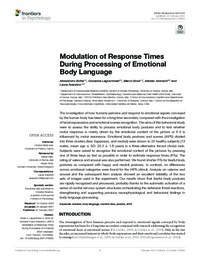Mostrar el registro sencillo de la publicación
Modulation of response times during processing of emotional body language
| dc.contributor.author | Botta, Alessandro | |
| dc.contributor.author | Lagravinese, Giovanna | |
| dc.contributor.author | Bove, Marco | |
| dc.contributor.author | Avenanti, Alessio | |
| dc.contributor.author | Avanzino, Laura | |
| dc.date.accessioned | 2022-01-14T12:24:26Z | |
| dc.date.available | 2022-01-14T12:24:26Z | |
| dc.date.issued | 2021 | |
| dc.identifier.uri | http://repositorio.ucm.cl/handle/ucm/3725 | |
| dc.description.abstract | The investigation of how humans perceive and respond to emotional signals conveyed by the human body has been for a long time secondary compared with the investigation of facial expressions and emotional scenes recognition. The aims of this behavioral study were to assess the ability to process emotional body postures and to test whether motor response is mainly driven by the emotional content of the picture or if it is influenced by motor resonance. Emotional body postures and scenes (IAPS) divided into three clusters (fear, happiness, and neutral) were shown to 25 healthy subjects (13 males, mean age ± SD: 22.3 ± 1.8 years) in a three-alternative forced choice task. Subjects were asked to recognize the emotional content of the pictures by pressing one of three keys as fast as possible in order to estimate response times (RTs). The rating of valence and arousal was also performed. We found shorter RTs for fearful body postures as compared with happy and neutral postures. In contrast, no differences across emotional categories were found for the IAPS stimuli. Analysis on valence and arousal and the subsequent item analysis showed an excellent reliability of the two sets of images used in the experiment. Our results show that fearful body postures are rapidly recognized and processed, probably thanks to the automatic activation of a series of central nervous system structures orchestrating the defensive threat reactions, strengthening and supporting previous neurophysiological and behavioral findings in body language processing. | es_CL |
| dc.language.iso | en | es_CL |
| dc.rights | Atribución-NoComercial-SinDerivadas 3.0 Chile | * |
| dc.rights.uri | http://creativecommons.org/licenses/by-nc-nd/3.0/cl/ | * |
| dc.source | Frontiers in Psychology, 12, 616995 | es_CL |
| dc.subject | Emotions | es_CL |
| dc.subject | Body language | es_CL |
| dc.subject | Reaction time | es_CL |
| dc.subject | Posture | es_CL |
| dc.subject | IAPS | es_CL |
| dc.title | Modulation of response times during processing of emotional body language | es_CL |
| dc.type | Article | es_CL |
| dc.ucm.facultad | Facultad de Ciencias de la Salud | es_CL |
| dc.ucm.indexacion | Scopus | es_CL |
| dc.ucm.indexacion | Isi | es_CL |
| dc.ucm.uri | www.frontiersin.org/articles/10.3389/fpsyg.2021.616995/full | es_CL |
| dc.ucm.doi | doi.org/10.3389/fpsyg.2021.616995 | es_CL |



